Looks, walks like small SUV, but Niro not fiddling
Filed under: Weekly test drives, Autos
By John Gilbert
With apologies to ancient Rome, as well as to ducks everywhere, we have more evidence that manufacturers are running out of vehicle names.
You know the theory that if something looks like a duck, walks like a duck and quacks like a duck, it must be a duck? How about if something looks like an SUV, hauls cargo like a small SUV, and conveys kids to school, hockey practice or the mall like an SUV — then it must be an SUV, right?
Not necessarily. It could also be a Kia Niro. True, it is not spelled like the old Roman ruler Nero, and in the ever-expanding world of compact crossover SUVs, it’s time to stop fiddling and take note of vehicles like the Niro.
It’s a lot like the new Toyota C-HR, which is about the same length and has a lot of similarities as the Niro. The biggest similarity they share is that they have front engines and are front-wheel drive…and that’s it. Neither has availability of all-wheel drive, which pretty much disqualifies both of them from being considered a real SUV, CUV, or any other “UVs” — utility vehicles.
The thing here is that the Kia Niro out-Toyotas Toyota in this new cute-wagon-and-don’t-call-me-an-SUV class. The Toyota C-HR has a 2.0-liter, 144-horsepower 4-cylinder engine pulling the 3,300-pound vehicle around, slowly. The Kia Niro, on the other hand, has an even smaller 1.6-liter direct-injected 4-cylinder with 146 horsepower — but it also has the latest and highest-tech 1.56 killowatt-hour electric battery pack from fellow-Korean electronics giant LG.
Running alongside cousin Hyundai’s new compact Ioniq sedan, the taller Niro has its battery pack stashed under the rear seat, connected in all the right places to become Kia’s first all-in hybrid vehicle.
Combining their power output, the Niro gets 103 horsepower from the 1.6 gas engine, plus 43 horsepower from the electric motor, boosting total torque to 195 foot-pounds.
Then there’s the transmission. Most hybrids drone along with a continuously variable transmission. Kia uses the Hyundai-built 6-speed dual-clutch automatic, which feels so much more potent than any CVT merely by providing real shift points, and can be operated as an engaging sport model, by manual shifting. Kia also put upgraded tires on the Niro, with Michelins on the test car. That helps the lightweight Niro and its potency run swiftly and benefit by a low center of gravity. Read more
Alfa Romeo Giulia TI repeats its grand entrance
Filed under: Weekly test drives, Autos
By John Gilbert
At the world-wide introduction of the Alfa Romeo Giulia, I had the good fortune to be among the assembled journalists summoned to Milano, Italy — Milan, to those who haven’t been there — when it was rolled out on stage. World-famous Italian tenor Andre Bocelli strolled on stage with it, serenading the room with a spectacular love song and putting the whole scenario over the top as a highly emotional event.
Those Italians know how to do emotion. Their magic is how they transform that quality into their cars!
Over the succeeding year, and numerous stops and starts that delayed the Giulia from reaching U.S. showrooms, it has finally made it. I’ve already written about the follow-up Stelvio, Alfa’s companion and the company’s first SUV, based on the Giulia.
Finally, I got to get bucket-seated inside a Giulia TI painted “Rosso Competzione Tri-Coat” red, to drive home from Chicago to Duluth, Minnesota. The wait was easily worth the reward.
I’ve always tried to suppress the hyperbole and press-release cliches when I write about cars, even though the bar has been raised so high by the always-improving new crop of vehicles, and so few deserve criticism nowadays. But restraining my impressions of the Giulia is more difficult, if not impossible.
Let’s start off by explaining that many of my friends have asked me, over the years, “OK, you drive new cars every week; what is your favorite of all time?” I always have checked my bet and explained that I have favorites in every style and type of vehicle, and in every price range, and here are a half-dozen…
Now I don’t have to hesitate. The Alfa Romeo Giulia TI is, without a doubt, my favorite car from the vast 50-year array of new cars I’ve driven.
Read more
Ioniq aims at top hybrid, electric status
Filed under: Weekly test drives, Autos
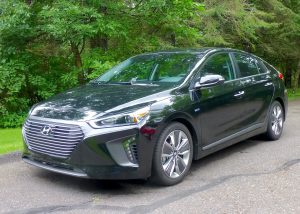
Hyundai cut every corner to create the Ioniq, a stylish compact with all forms of hybrid/electric power.
By John Gilbert
If there were no such thing as hybrid or electric cars, and buying a car meant nothing more than the size of vehicle we want and any of various degrees of efficient gasoline engines, you might select a Hyundai Ioniq as a stylish, attractively-styled car that somehow fits the spaciousness of a larger car into the low, sleek exterior of a compact.
Such a car might get 30 miles per gallon, because of the aerodynamics and the efficiency of contemporary gas engines. But, of course, we are well along into the era of hybrid cars, which combine gas engines and electric motors, as we roll merrily toward pure electric propulsion, and when I got the Ioniq out on an extended highway trip, its calculator displayed 52.1 miles per gallon for 400 miles.
The Ioniq is Hyundai’s well-conceived weapon of choice in the corporate warfare aimed at hybrid and electric superiority — a realm that has been the almost-private domain of Toyota with its hugely popular Prius. I was impressed when I drove the various models at the Ioniq Midwestern introduction near Ann Arbor, Mich., and I am more impressed since a glossy “black noir” Ioniq Limited pulled up in my driveway just outside Duluth, Minn., for a week-long hands-on test.
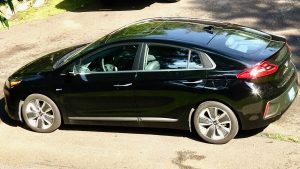
Ioniq has short engine room and high-tech hybrid battery under rear seat leaving elongated interior.
Hyundai has spared nothing in working with fellow-South Korean electronics giant LG Chem to come up with what we might refer to as a “better mousetrap.” Only the Ioniq is not attempting to trap mice; it would settle for bypassing something known as Prius.
The Toyota Prius has been the standard of hybrid sales for over a decade, and superb marketing and efficiency have outdistanced competitors from Honda, and virtually all other manufacturers. The Toyota Synergy Drive is quite simple, with a nickel-metal-hydride battery pack taking in energy from the gas engine that accompanies it, allowing the Prius to run on either pure electric, or a combination of gas-engine and electric motor.
Not many drawbacks, but if any, they would be a lack of storage room in the trunk, a lack of sporty feel in the performance and handling, and such a consistency in operation that a smarter populace might wonder why the advancement in hybrid technology seems stalled a bit. Toyota has expanded the Prius line with a longer version and a shorter plug-in model.
Hyundai, meanwhile, has emerged in less than a decade to challenge the top Japanese companies in style and efficiency, and while going after sportiness, Hyundai has scaled various technology challenges to battle for the top rung. The company has tried a couple of hybrid models, all the while mobilizing for the 2017 model year and the introduction of the three-pronged Ioniq strategy. Read more
Sport means SUV compacting has gone Rogue
Filed under: Weekly test drives, Autos
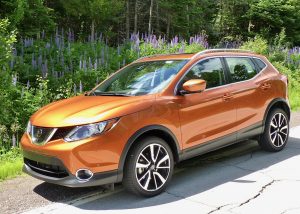
The Nissan Rogue is such a popular SUV it has expanded into a new and more compact vehicle, the Rogue Sport.
By John Gilbert
Funny how your perspective can change when assessing vehicles. Two or three years ago, my favorite SUVs were compact crossovers, and a perfect example was the Nissan Rogue.
With so many compact SUVs — or CUVs, if you prefer Crossover Utility Vehicles — available, the Rogue seemed to stand out, one of those tight, sporty, good-handling, and efficient vehicles that almost seemed to be custom made for my wife, Joan, and me.
Obviously, a few other people shared our view, because Nissan sold 360,000 of them, claiming the No. 1 spot in the crossover segment, and would be the largest selling “truck” if you eliminated the three big pickup trucks from Ford, Chevy and Dodge.
But suddenly, the Rogue seems too big! No, it hasn’t grown all that much. But there is now a Rogue Sport, which looks a lot like the Rogue from the front end, the front corner, and even the side and rear, until you look closely.

Nissan magically retained the style and nearly the same interior room although the Rogue Sport is a foot shorter than the popular Rogue.
The Rogue Sport is a foot shorter, and 6 inches lower, but it also is a lot more than just a miniturized Rogue. Honda, Toyota, Mazda, Ford, Chevrolet — nearly everyone — has come out with a reduced size SUV based on their smallest SUV.
The strategy was probably what you and I might have done if we had the design scalpal in our hands, which is simply to reduce dimensions from front to rear. But Nissan was a lot smarter than that. Most, if not all, of the competitors are left with a sprightly, sporty compact crossover, still with adequate room in the front buckets and adequate cargo space, but with tightly squeezed rear seat legroom.
But Nissan decided to reduce the one foot of length by carving into the cargo space, behind the second seat. It was an ingenious move, because the Rogue Sport has virtually the same front seat and second row room as the big Rogue, it just has less cargo space.
For those who might not need a third row seat, and might not have the need to haul as much cargo as the bigger Rogue, giving up a little cargo space is far preferable to cutting rear seat living room to near nothing.
The Rogue Sport is 172.4 inches long, with a 104.2-inch wheelbase. It has 42.8 inches of front legroom, and 33.4 inches of rear legroom. It also has surprisingly adequate cargo space of 33.3 cubic feet with the second row seat up, or 62.3 with it folded down.
The bigger Rogue has a strong 2.5-liter 4-cylinder engine, delivering 170 horsepower and 174 foot-pounds of torque in all-wheel-drive form, via a continuously variable transmission. The shorter and lighter Rogue doesn’t get the 2.5, but gets Nissan’s neat 2.0-liter 4, with 142 horsepower peaking at 6,000 RPMs and 147 foot-pounds of torque at 4,400 revs.
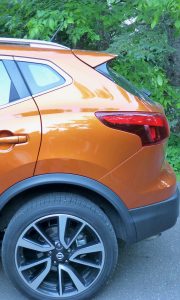
Close inspection reveals shorter rear section, the only hint that the Rogue Sport is a foot shorter.
Driving both of them, you don’t realize the Sport has a smaller engine, because its size and weight makes it feel quicker responding and generally quicker. Compact crossovers from companies like Nissan or Mazda energize the whole industry by proving even SUVs can be fun to drive and have sporty personalities.
Perhaps the biggest asset, after its size and visual appeal, is the price of the Rogue. The base S Rogue starts at $21,420; moving up to the SV gains larger 17-inch wheels and some other amenities, and starts at $23,020; the top SL, which I drove, starts at $26,070.
The SL moves up to 19-inch wheels, and all the top-line features, including leather interior, surround view, lane-departure detection and prevention, as well as the full suite of safety and connectivity items from the S and SV models.
The fact that I had the chance to spend a week with the Rogue SL a short time before the Rogue Sport SL showed up gave me the unique perspective of a better comparison. As mentioned, the Rogue has always been a family favorite, and we were doubly impressed by the Rogue Sport.
Open the door and climb into the front bucket, and you might be in the Rogue. Same with the back seat. But after driving the Rogue, and then the Rogue Sport, the next time I got into the “regular” Rogue the Rogue Sport never seemed too small, but the regular Rogue suddenly seemed, maybe, too big!
Picking new vehicle now has expanded scope
Filed under: Weekly test drives, Autos

Sporty SUV is Infiniti QX-30 in foreground; sleek sports coupe is Lexus RC350 left rear; latest version of hot hatchback is Volkswagen Golf R, upper right.
By John Gilbert
A Volkswagen Golf showed up for a test-drive, but not just a Golf. In fact, not just a GTI. It was the Golf R, a Golf bristling with high-performance stuff that makes it the most dynamic and impressive member of the Golf family. At the same time, our driveway was graced by the presence of one of my favorite compact crossover SUVs — an Infiniti QX30 Sport.
Also, there was a Lexus, but not just a Lexus. It was a Lexus RC350. If you’re not up on the alphabet-soup of car-talk, this is a beautiful coupe, that could easily pass for an exotic sports car costing twice as much.
The biggest challenge I had for the week was deciding which car to be driving at any particular moment. I drove one up to the Duluth Farmer’s Market on 14th Ave. East and 3rd Street. A good friend and I were talking, and he knows I’m road-testing new cars every week, so he said: “If you had $50,000 to spend on a car right now, what would you buy?”
The question caught me off-guard, and I found it really difficult to answer, simply because there are so many fantastic vehicles available right now. Many, in fact, are well under his $50,000 price ceiling. So I rattled off a list of a half-dozen cars I really like, and a half-dozen compact SUVs that I wouldn’t hesitate to buy, and then a handful of impressive sporty coupes that I’d love to have.
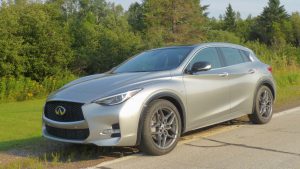
Infiniti’s smallest and sleekest SUV is the QX-30, with a potent but economical 2.0-liter 4 cylinder and paddle shifters.
But I couldn’t get the question out of my mind as I returned home. Then I glanced out of my window toward our little turnaround area at the end of our driveway. By sheer chance, two auto distribution agencies had delivered to me three different vehicles for a week, and it was my challenge to hop back and forth to get into all of them adequately in order to give them fair evaluations.
What was interesting is all three of them were distinctly different, in distinctly different segments of the auto market, and all just happened to fall into the $40,000 to just under-$50,000 price range. Exactly what my friend was asking about.
So while it’s fun to compare several small SUVs, or large SUVs, or sporty coupes, or sedans, against each other, for a timely change of pace, here are three vehicles that all might be worthy of consideration, even though their objectives are worlds apart.
If you want a small crossover SUV, the Infiniti QX30 is among my favorites. It is low and sporty, with curves and contours built into the side styling, and it looks both distinctive and sporty and almost lets you overlook that it’s actually an SUV.
The QX-30 is both mild and hot with its 2.0-liter turbocharged 4, depending on how you drive it. Just be prepared to feel as though you’re driving a sports car the way it deftly handles any turn or quick reacting situation. This one had a list price of $38,500, but with the Sport package and other options it listed at $43,660.
This was a 2018 model, and the Sport technology package includes blind-spot detection, lane-departure warning, forward emergency braking, and a panoramic sunroof, which Nissan — or at least its Infiniti upgrade arm — prefers to call a moonroof.
The QX30 Sport comes with the intriguing new 2.0-liter 4-cylinder turbocharged engine that was designed by Mercedes Benz and built for both companies by Nissan. In the QX30, it develops 208 horsepower and 258 foot-pounds of torque, running through a 7-speed dual-clutch transmisison with steering wheel paddles.
You can click a console control knob to Eco, Normal, or Sport modes and immediately feel the difference in how firm the suspension is and how crisp or softened the steering becomes. Fuel figures from the EPA are 24 city and 33 highway, but there is one thing about this particular model: It is front-wheel drive. With the sport suspension and steering, you feel as though it could conquer any challenge, but when winter hits on the Duluth hillside, AWD is a welcome addition. But at least with the QX30, the 2-wheel drive is front-wheel drive, so it should scamper up the hills if you put the right tires on it.
One thing I didn’t like about the car was that as precise as the 7-speed automatic was, the console shift lever could be pushed forward to go past neutral to reverse…but that’s it. In a hurry, you might start to jump out and not realize you’ve left the gear in reverse until it rolls backwards. Perhaps into the bay. There is a small push button on the face of the console, and you must push it down to engage park. And then you’d better check the instrument panel to make sure it’s engaged. That’s a very German trick, but why must we be issued fantastic new cars with ambiguous and counter-intuitive trick settings just to find park? Read more





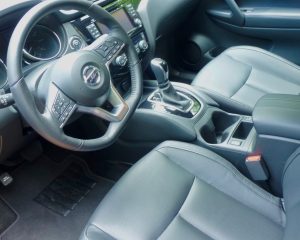

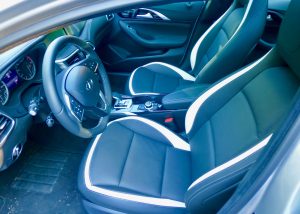
 John Gilbert is a lifetime Minnesotan and career journalist, specializing in cars and sports during and since spending 30 years at the Minneapolis Tribune, now the Star Tribune. More recently, he has continued translating the high-tech world of autos and sharing his passionate insights as a freelance writer/photographer/broadcaster. A member of the prestigious North American Car and Truck of the Year jury since 1993. John can be heard Monday-Friday from 9-11am on 610 KDAL(www.kdal610.com) on the "John Gilbert Show," and writes a column in the Duluth Reader.
John Gilbert is a lifetime Minnesotan and career journalist, specializing in cars and sports during and since spending 30 years at the Minneapolis Tribune, now the Star Tribune. More recently, he has continued translating the high-tech world of autos and sharing his passionate insights as a freelance writer/photographer/broadcaster. A member of the prestigious North American Car and Truck of the Year jury since 1993. John can be heard Monday-Friday from 9-11am on 610 KDAL(www.kdal610.com) on the "John Gilbert Show," and writes a column in the Duluth Reader.